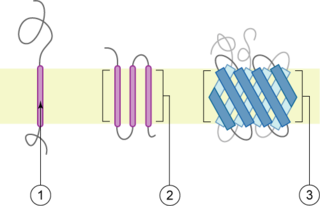The Na-K-Cl cotransporter (NKCC) is a protein that aids in the active transport of sodium, potassium, and chloride into cells. In humans there are two isoforms of this membrane transport protein, NKCC1 and NKCC2, encoded by two different genes. Two isoforms of the NKCC1/Slc12a2 gene result from keeping or skipping exon 21 in the final gene product.

Neutral and basic amino acid transport protein rBAT is a protein that in humans is encoded by the SLC3A1 gene.
An Error has occurred retrieving Wikidata item for infobox Thiamine transporter 2 (ThTr-2), also known as solute carrier family 19 member 3, is a protein that in humans is encoded by the SLC19A3 gene. SLC19A3 is a thiamine transporter.
A urea transporter is a membrane transport protein, transporting urea. Humans and other mammals have two types of urea transport proteins, UT-A and UT-B. The UT-A proteins are important for renal urea handling and are produced by alternative splicing of the SLC14A2 gene. Urea transport in the kidney is regulated by vasopressin.
Electrogenic sodium bicarbonate cotransporter 1 is a membrane transport protein that in humans is encoded by the SLC4A4 gene.

Solute carrier family 22 member 2 is a protein that in humans is encoded by the SLC22A2 gene.

Solute carrier family 26 member 6 is a protein that in humans is encoded by the SLC26A6 gene. It is an anion-exchanger expressed in the apical membrane of the kidney proximal tubule, the apical membranes of the duct cells in the pancreas, and the villi of the duodenum.

Solute carrier family 22 member 8, or organic anion transporter 3 (OAT3), is a protein that in humans is encoded by the SLC22A8 gene.

Sodium-dependent multivitamin transporter is a protein that in humans is encoded by the SLC5A6 gene.

Solute carrier family 2, facilitated glucose transporter member 12 is a protein that in humans is encoded by the SLC2A12 gene.

Multidrug and toxin extrusion protein 1 (MATE1), also known as solute carrier family 47 member 1, is a protein that in humans is encoded by the SLC47A1 gene. SLC47A1 belongs to the MATE family of transporters that are found in bacteria, archaea and eukaryotes.

Urea transporter 2 is a protein that in humans is encoded by the SLC14A2 gene.

Sodium-dependent phosphate transport protein 1 is a protein that in humans is encoded by the SLC17A1 gene.

Solute carrier family 13 member 3 also called sodium-dependent dicarboxylate transporter (NaDC3) is a protein that in humans is encoded by the SLC13A3 gene.

Solute carrier family 22 member 9 is a protein that in humans is encoded by the SLC22A9 gene.
An Error has occurred retrieving Wikidata item for infobox Electrogenic sodium bicarbonate cotransporter 4 is a protein that in humans is encoded by the SLC4A5 gene.
GABA transporters (Gamma-Aminobutyric acid transporters) belong to the family of neurotransmitters known as sodium symporters, also known as solute carrier 6 (SLC6). These are large family of neurotransmitter which are Na+ concentration dependent. They are found in various regions of the brain in different cell types, such as neurons and astrocytes. These transporters are primarily responsible for the regulation of extracellular GABA concentration during basal and synaptic activity. They are responsible to create a GABA gradient which is determined by the membrane potential, and the concentration of Na+ and Cl-. They are also present on the plasma membrane of neurons and glia which help define their function of regulation of GABA concentration as they act as the receptors that facilitate recycling of GABA in the extracellular space. GABA transporters often are the main sites that are aimed by lot of anticonvulsant drugs in order to avoid seizure disorders such as epilepsy.

The plasma membrane monoamine transporter (PMAT) is a low-affinity monoamine transporter protein which in humans is encoded by the SLC29A4 gene. It is known alternatively as the human equilibrative nucleoside transporter-4 (hENT4). Unlike other members of the ENT family, it is impermeable to most nucleosides, with the exception of the inhibitory neurotransmitter and ribonucleoside adenosine, which it is permeable to in a highly pH-dependent manner.

The organic anion transporter 1 (OAT1) also known as solute carrier family 22 member 6 (SLC22A6) is a protein that in humans is encoded by the SLC22A6 gene. It is a member of the organic anion transporter (OAT) family of proteins. OAT1 is a transmembrane protein that is expressed in the brain, the placenta, the eyes, smooth muscles, and the basolateral membrane of proximal tubular cells of the kidneys. It plays a central role in renal organic anion transport. Along with OAT3, OAT1 mediates the uptake of a wide range of relatively small and hydrophilic organic anions from plasma into the cytoplasm of the proximal tubular cells of the kidneys. From there, these substrates are transported into the lumen of the nephrons of the kidneys for excretion. OAT1 homologs have been identified in rats, mice, rabbits, pigs, flounders, and nematodes.
GABA transporter 2 also known as sodium- and chloride-dependent GABA transporter 2 is one of four GABA transporters, GAT1 (SLC6A1), GAT2 (SLC6A13), GAT3 (SLC6A11) and BGT1 (SLC6A12). Note that GAT2 is different from BGT1 despite the fact that the latter transporter is sometimes refereed at as (mouse) GAT-2.















